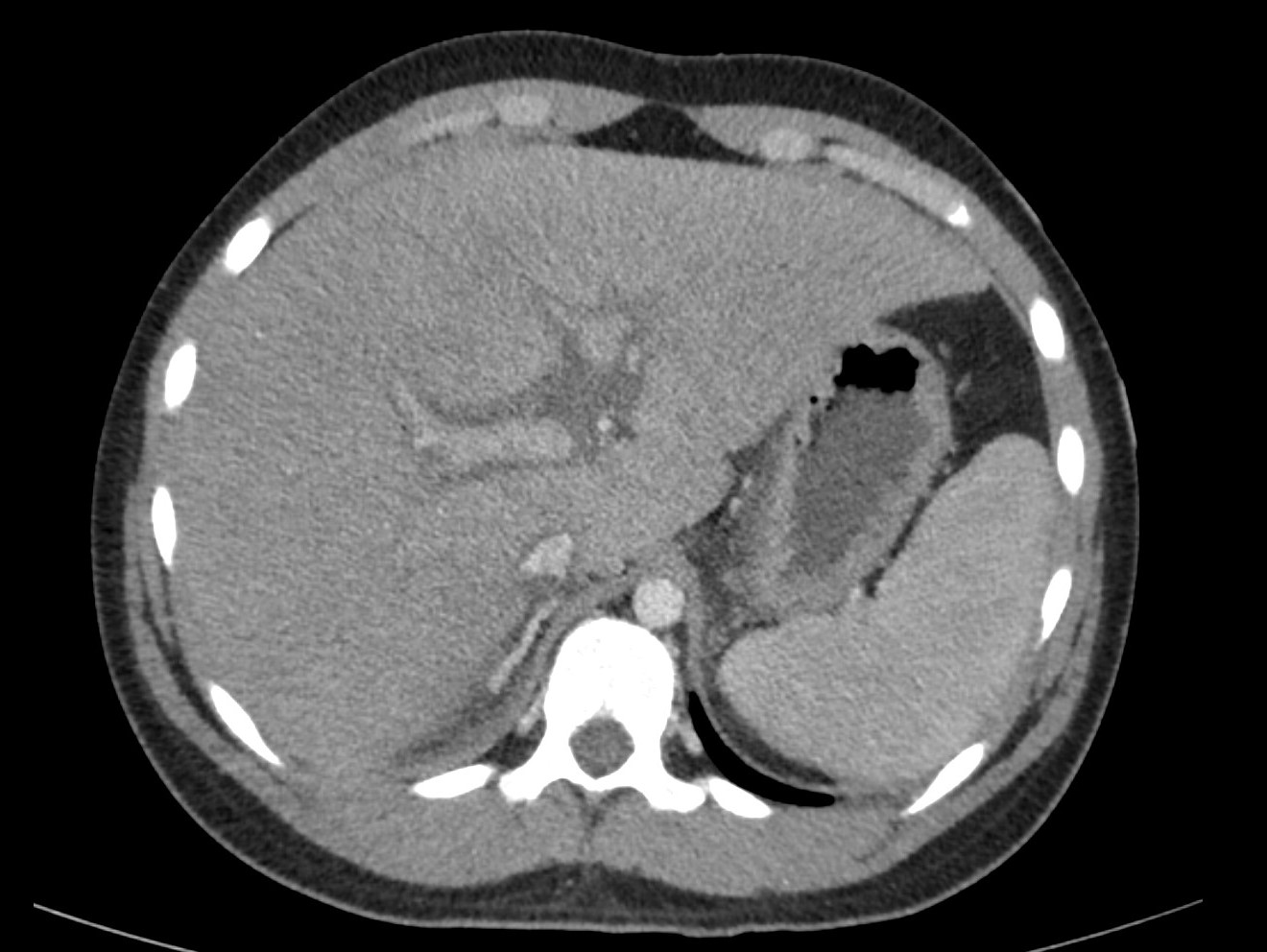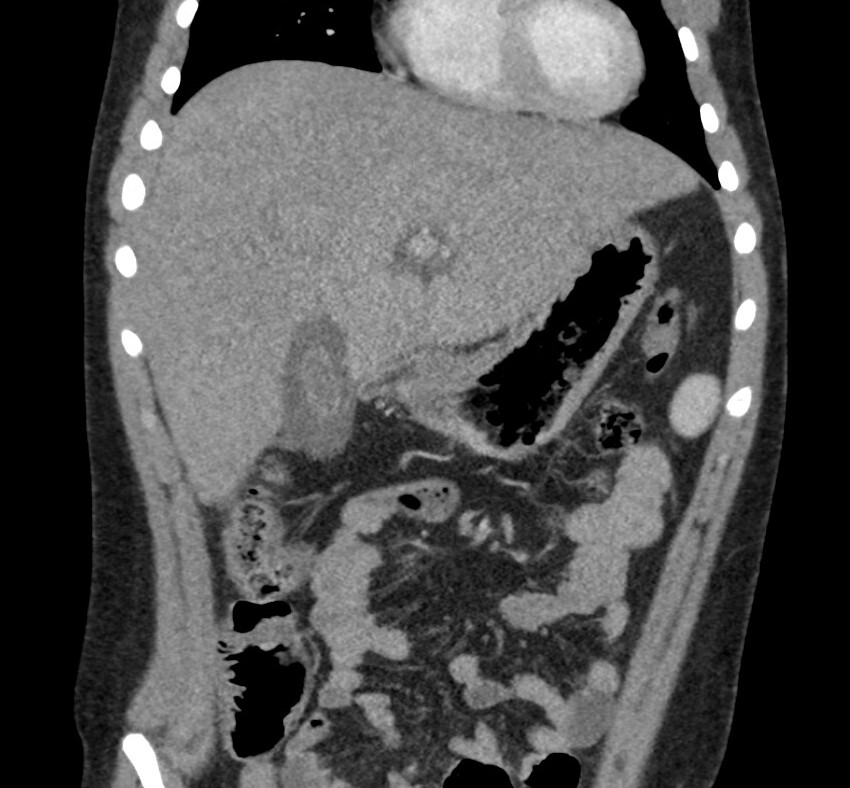Tuesday Poster Session
Category: Liver
P6092 - Hepatic Cry for Help: A Case of HSOS (Hepatic Sinusoidal Obstructive Syndrome) After Brentuximab and Dacarbazine Chemotherapy
Tuesday, October 28, 2025
10:30 AM - 4:00 PM PDT
Location: Exhibit Hall
- MA
Michael Adams, DO (he/him/his)
Walter Reed National Military Medical Center
Bethesda, MD
Presenting Author(s)
Michael Adams, DO, Katharine Salyer, MD, Dean Baird, MD
Walter Reed National Military Medical Center, Bethesda, MD
Introduction: Hepatic Sinusoidal Obstructive Syndrome (HSOS) is caused by acute obstruction of the hepatic sinusoids that is an often life-threatening condition. Hepatic sinusoids are microvascular conduits lined by Liver Sinusoidal Endothelial Cells (LSECs) that are closely associated with hepatocytes and assist with toxin elimination, pressure regulation and liver regeneration. HSOS develops from toxic injury to the LSECs from numerous causes including metabolites from chemotherapy. Radiologic evaluation often provides the first initial clues to the diagnosis. We present a case of HSOS in the setting of recent Brentuximab and Dacarbazine infusion for the management of advanced Hodgkin Lymphoma.
Case Description/
Methods: A 19-year-old male with a history of advanced Mixed Cellularity (Classic) Hodgkin Lymphoma who previously experienced hepatotoxicity secondary to Nivolumab was transitioned to BV-AVD (Brentuximab/Doxorubicin/Vinblastine/Dacarbazine) infusions. After his 3rd infusion, he presented with acute abdominal pain, vomiting and fever. Transaminases were found to be severely elevated (AST 4689, ALT 3442) with associated coagulopathy (INR 2.49). CT Abdomen/Pelvis showed diffuse periportal edema, hepatosplenomegaly, heterogenous liver parenchyma (nutmeg appearance) concerning for HSOS. Defibrotide was initiated after MICU admission. He was subsequently transferred to a liver transplant center given concern for acute liver failure with MELD score 26. Fortunately, after a course of IV Decadron and supportive management, his condition steadily improved. Patient showed normalization on repeat imaging and completed treatment of his lymphoma.
Discussion: HSOS is a serious, life-threatening condition often leading to Acute Liver Failure. This cases demonstrates HSOS secondary to toxic metabolites from chemotherapy. Brentuximab, an anti-CD30 monoclonal antibody conjugated with a microtubule inhibitor designed to induce cell cycle arrest, is associated with less than 50 cases of Hepatotoxicity. This usually presents as mild elevations in transaminases, no cases of HSOS have been reported. Dacarbazine has a more robust association with HSOS and cases are often fatal. It is difficult to clearly delineate which chemotherapeutic agent caused HSOS in this patient although Dacarbazine is favored. This case shows the importance of an early radiologic diagnosis to raise clinical suspicion for HSOS in order to initiate proper treatment to optimize patient outcomes.

Figure: Axial image showing marked periportal edema in addition to diffuse heterogeneous liver parenchyma (nutmeg liver) characteristic of HSOS.

Figure: Coronal image showing gallbladder mural thickening and hepatomegaly consistent with severe hepatic congestion secondary to HSOS.
Disclosures:
Michael Adams indicated no relevant financial relationships.
Katharine Salyer indicated no relevant financial relationships.
Dean Baird indicated no relevant financial relationships.
Michael Adams, DO, Katharine Salyer, MD, Dean Baird, MD. P6092 - Hepatic Cry for Help: A Case of HSOS (Hepatic Sinusoidal Obstructive Syndrome) After Brentuximab and Dacarbazine Chemotherapy, ACG 2025 Annual Scientific Meeting Abstracts. Phoenix, AZ: American College of Gastroenterology.
Walter Reed National Military Medical Center, Bethesda, MD
Introduction: Hepatic Sinusoidal Obstructive Syndrome (HSOS) is caused by acute obstruction of the hepatic sinusoids that is an often life-threatening condition. Hepatic sinusoids are microvascular conduits lined by Liver Sinusoidal Endothelial Cells (LSECs) that are closely associated with hepatocytes and assist with toxin elimination, pressure regulation and liver regeneration. HSOS develops from toxic injury to the LSECs from numerous causes including metabolites from chemotherapy. Radiologic evaluation often provides the first initial clues to the diagnosis. We present a case of HSOS in the setting of recent Brentuximab and Dacarbazine infusion for the management of advanced Hodgkin Lymphoma.
Case Description/
Methods: A 19-year-old male with a history of advanced Mixed Cellularity (Classic) Hodgkin Lymphoma who previously experienced hepatotoxicity secondary to Nivolumab was transitioned to BV-AVD (Brentuximab/Doxorubicin/Vinblastine/Dacarbazine) infusions. After his 3rd infusion, he presented with acute abdominal pain, vomiting and fever. Transaminases were found to be severely elevated (AST 4689, ALT 3442) with associated coagulopathy (INR 2.49). CT Abdomen/Pelvis showed diffuse periportal edema, hepatosplenomegaly, heterogenous liver parenchyma (nutmeg appearance) concerning for HSOS. Defibrotide was initiated after MICU admission. He was subsequently transferred to a liver transplant center given concern for acute liver failure with MELD score 26. Fortunately, after a course of IV Decadron and supportive management, his condition steadily improved. Patient showed normalization on repeat imaging and completed treatment of his lymphoma.
Discussion: HSOS is a serious, life-threatening condition often leading to Acute Liver Failure. This cases demonstrates HSOS secondary to toxic metabolites from chemotherapy. Brentuximab, an anti-CD30 monoclonal antibody conjugated with a microtubule inhibitor designed to induce cell cycle arrest, is associated with less than 50 cases of Hepatotoxicity. This usually presents as mild elevations in transaminases, no cases of HSOS have been reported. Dacarbazine has a more robust association with HSOS and cases are often fatal. It is difficult to clearly delineate which chemotherapeutic agent caused HSOS in this patient although Dacarbazine is favored. This case shows the importance of an early radiologic diagnosis to raise clinical suspicion for HSOS in order to initiate proper treatment to optimize patient outcomes.

Figure: Axial image showing marked periportal edema in addition to diffuse heterogeneous liver parenchyma (nutmeg liver) characteristic of HSOS.

Figure: Coronal image showing gallbladder mural thickening and hepatomegaly consistent with severe hepatic congestion secondary to HSOS.
Disclosures:
Michael Adams indicated no relevant financial relationships.
Katharine Salyer indicated no relevant financial relationships.
Dean Baird indicated no relevant financial relationships.
Michael Adams, DO, Katharine Salyer, MD, Dean Baird, MD. P6092 - Hepatic Cry for Help: A Case of HSOS (Hepatic Sinusoidal Obstructive Syndrome) After Brentuximab and Dacarbazine Chemotherapy, ACG 2025 Annual Scientific Meeting Abstracts. Phoenix, AZ: American College of Gastroenterology.
